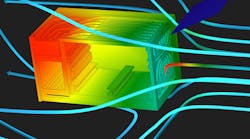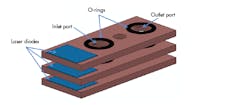Download this article in PDF format.
Thermal management can be an important step in achieving a long operating lifetime for the circuits and devices in a defense electronics system. Active devices such as power transistors and laser diodes are never 100% efficient, which means some amount of power applied to these devices will be converted to heat. The lower the efficiency, the more heat is generated for a given amount of applied power.
To prevent damaging heat buildup around an active device, the heat must be dissipated into the surrounding environment or into the materials within a system. Different materials and structures can serve this purpose. However, with the current trend of designing greater functionality into smaller packages, DARPA and many other military organizations appear to be on a relentless quest for more effective heat-removing materials with outstanding thermal properties.
Part of the miniaturization push in military electronics involves increased use of active devices with high power densities, such as laser diodes and gallium-nitride-on-silicon-carbide (GaN-on-SiC) power transistors. While such devices are capable of high output power in terms of optical and electromagnetic (EM) signal energy, respectively, they are still less than 50% efficient. Therefore, a great deal of power-supply and input signal power will be converted to heat within a relatively small package area. Ideally, such heat can be channeled away by using printed-circuit-board (PCB) materials that encourage the heat flow or additional materials and structures that can help form thermal channels.
Channeling the Heat
Understanding the basic thermal properties of standard materials can ease the task of forming these thermal channels. For cooling purposes, one of the most essential material properties is thermal conductivity, or its capacity to conduct heat, which is measured in watts of power per meter per degree Kelvin (W/m-K). The inverse of thermal conductivity is thermal resistance. So, a material with good heat flow will have high thermal conductivity and, at the same time, low thermal resistance.
Microchannel coolers (MCCs) are structures with chambers for cooling liquids. Stacks of MCCs such as this can be used to cool multiple devices. (Courtesy of Micro Cooling Concepts Inc.)
Copper is one of the more commonly used materials in electronic circuits with high thermal conductivity, about 400 W/m-K. Aluminum is another excellent thermal conductor, at about 235 W/m-K, often found in electronic circuits and systems. Of course, in electronic circuits, copper transmission lines (and thermal paths) are fabricated on dielectric substrate materials, such as polytetrafluoroethylene (PTFE) or various forms of ceramic materials that will have different values of thermal conductivity. The junction between different materials that must channel heat, such as copper lines on a ceramic substrate, is an area of concern not only for differences in the thermal conductivities of the materials, but in the way the materials respond to elevated temperatures.
The coefficient of thermal expansion (CTE) is a key material parameter that describes how much a material will increase in size as a function of temperature. For an effective thermal path, materials with high thermal conductivities are desired, as are materials with closely matched CTEs, to minimize stresses at the junctions of the materials when they expand with temperature. While air gaps between two attached materials, such as a power transistor mounted to a heatsink, can provide room for expansion between two materials with different CTEs, air has poor thermal conductivity, at about 0.024 W/m-K. A better thermal interface can be formed by using thermal paste to fill the air gaps.
Three-dimensional (3D) structures typically formed of thermally conductive metals or other materials are often used within circuits and systems to aid the flow of heat away from active devices. These structures include heatsinks, heatpipes, and miniature microchannel coolers (MCCs). MCCs (see figure) are structures that include channels for the flow of a cooling liquid, such as deionized water, to promote heat flow away from devices with high power density, such as laser diodes. The thermal conductivity of an MCC can be improved by increasing the flow rate of the liquid through the MCC’s channels.
Military designers are faced with thermal-management challenges at all levels, from device through system, and the control of power and heat is essential for all branches as detailed by DARPA’s Thermal Management Technologies (TMT) Program. It essentially seeks material advances, particularly on the nanostructure scale, to properly manage heat in present and future defense electronic systems.


